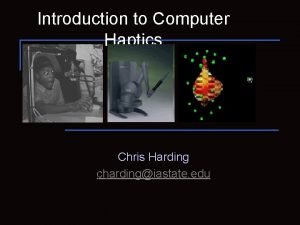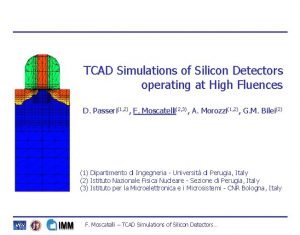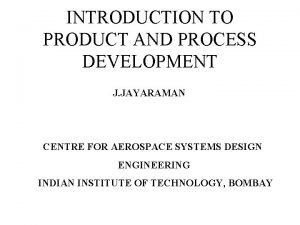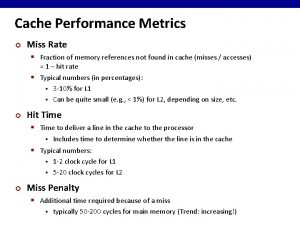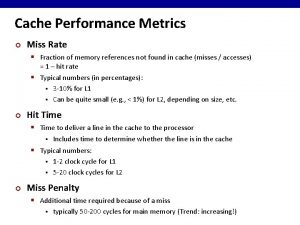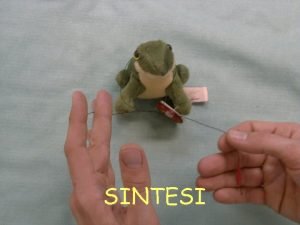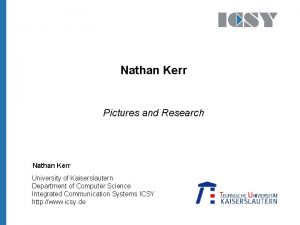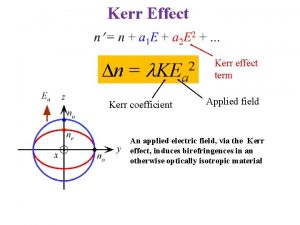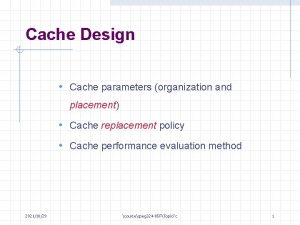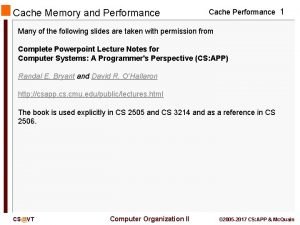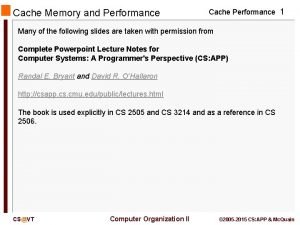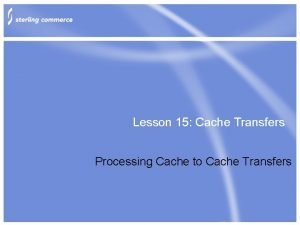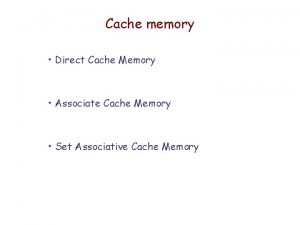Cache Simulations and Application Performance Christopher Kerr kerrgfdl


















- Slides: 18

Cache Simulations and Application Performance Christopher Kerr (kerr@gfdl. gov) Philip Mucci (mucci@cs. utk. edu) Jeff Brown (jeffb@lanl. gov Los Alamos, Sandia National Laboratories

Goal • To optimize large, numerically intensive applications with poor cache utilization. • By taking advantage of the memory hierarchy and we can often achieve the greatest performance improvements for our time.

Philosophy • By simulating the cache hierarchy, we wish to understand how the application’s data maps to a specific cache architecture. • In addition, we wish to understand the application’s reference pattern and the relationship to the mapping. • Performance improvements can be obtained from this information algorithmically.

Cache Simulator Consists of: – Instrumentation assistant (Perl) – Header files – Run-time library to be linked with the application (C) Works with: – C, C++, Fortran 77, Fortran 90

How it works • Cache simulator is called on memory (array) references • Cache simulator reads a configuration file containing an architectural description of the memory hierarchy for multiple machines. • Environment variables enable different options

How it works (cont) • Each call to the simulator provides as input: – Address of the reference – Size of the datum being accessed – Symbolic name consisting of the name, file and line number

Instrumentation (before) subroutine kji(A, ii, jj, lda, B, kk, ldb, C, ldc) dimension A(lda, lda), B(ldb, ldb), C(ldc, ldc) do k = 1, kk do j = 1, jj do i = 1, ii A(i, j) = A(i, j) + B(i, k) * C(k, j) enddo return end

Instrumentation (after). . . do i = 1, ii call cache_sim(A(i, j), KIND(A(i, j)), & 'A(i, j): 7: stdin�') call cache_sim(B(i, k), KIND(B(i, k)), & 'B(i, k): 7: stdin�') call cache_sim(C(k, j), KIND(C(k, j)), & 'C(k, j): 7: stdin�') A(i, j) = A(i, j) + B(i, k) * C(k, j) enddo. . .

Output • • • Summary Misses by name Misses by address Conflict matrix Address trace

Summary Machine 1: test-machine Cache level 1: size 32 k. B, line size 32 B, associativity 2, 1024 lines total ----------------Total mem accesses: 166492. 00 Total cache misses: 10276. 00 Total cache hits: 156216. 00 Total hit rate: 93. 83 ----------------Num split accesses: 0. 00 Cold cache misses: 1024. 00 Real misses: 9252. 00 Real hit rate: 94. 41

Misses by name Name Trace: miss rate for references >= 0 percent. Percentage Real misses Line: File: Reference 0. 01 1. 000 X(i, j): 26: stencil. F 0. 01 1. 000 X(i, j-1): 26: stencil. F 9. 08 840. 000 R(i, j): 26: stencil. F 0. 12 11. 000 X(i+1, j-1): 26: stencil. F 9. 08 840. 000 X(i+1, j+1): 26: stencil. F 9. 08 840. 000 AN(i, j): 26: stencil. F 7. 61 704. 000 ANE(i, j): 17: stencil. F 7. 61 704. 000 AN(i, j): 15: stencil. F 0. 13 12. 000 ANE(i, j-1): 26: stencil. F 9. 08 840. 000 ANE(i, j): 26: stencil. F. . .

Misses by address Address Trace: miss rate for references >= 0 percent. Percentage Real misses Address Line: File: Reference 0. 01 1. 000 0 x 32 d 60 R(i, j): 13: stencil. F 0. 01 1. 000 0 x 32 d 80 R(i, j): 13: stencil. F 0. 01 1. 000 0 x 32 da 0 R(i, j): 13: stencil. F 0. 01 1. 000 0 x 32 dc 0 R(i, j): 13: stencil. F 0. 01 1. 000 0 x 32 de 0 R(i, j): 13: stencil. F 0. 01 1. 000 0 x 32 e 00 R(i, j): 13: stencil. F. . .

Conflict matrix • Each axis represents the different arrays • X axis is replacer, Y is replacee • Elements are the number of replacements of one array element with another • Goal is to algorithmically determine optimal layout, placement, padding and blocking. • This is a minimization problem.

Conflict matrix (cont) 0 1 2 Num 0 1 2 0 1 100 50 20 10 50 0 2 20 10 0 Name A(i, j): 7: kji. f B(i, k): 7: kji. f C(k, j): 7: kji. f

Address dump • • Symbolic name Virtual address Cache line Goal is to use this for replay.

Future • Handle nonblocking caches, replacement policies, write strategies and buffering. • Add output file with starting address and extents for each array. • Facility for replay of the simulator using the address dump, and data regarding padding, blocking and alignment. This will eliminates the need for additional runs.

Future (cont) • Categorize cold misses for repeatedly accessed data items. • Provide cost metrics to analyze approximate performance loss due to poor locality. • Full Lex/Yacc based parser. • Perl/Tk GUI for finer control of instrumentation.

Future (cont) • • MPI, Thread aware Reduction in run-time requirements MUT integration Tools to compare data sets
 Steve kerr madeleine kerr
Steve kerr madeleine kerr Dr mark kerr
Dr mark kerr Our teacher will go to leipzig tomorrow
Our teacher will go to leipzig tomorrow Don't gamble with physical properties for simulations
Don't gamble with physical properties for simulations Clinical simulations in nursing education
Clinical simulations in nursing education Chris harding simulations
Chris harding simulations Tcad simulations
Tcad simulations World history simulations
World history simulations Simulations for solid state physics
Simulations for solid state physics Payroll card
Payroll card Ippd key tenets
Ippd key tenets Baton simulations
Baton simulations Cache performance metrics
Cache performance metrics Cache performance metrics
Cache performance metrics Dr ashley kerr
Dr ashley kerr Gary kerr omaha
Gary kerr omaha викрил 4 0
викрил 4 0 Kerr lake regional water system
Kerr lake regional water system Kerr coefficient
Kerr coefficient





